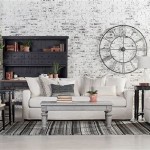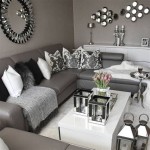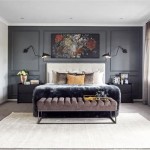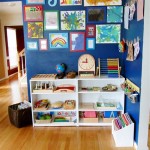How to Decorate a Grey Living Room
Grey living rooms have become increasingly popular due to their versatility and sophisticated appeal. Grey serves as an exceptional neutral backdrop, allowing for experimentation with various color palettes, textures, and design styles. Decorating a grey living room requires careful consideration of several factors, including the specific shade of grey, natural light availability, and the desired ambiance.
Successfully decorating a grey living room involves a strategic approach focusing on color balance, textural contrast, and the incorporation of personal style. This guide offers comprehensive insights into creating a visually appealing and comfortable grey living space.
Choosing the Right Shade of Grey
The foundation of a well-decorated grey living room lies in selecting the appropriate shade of grey. Grey exists on a spectrum, ranging from cool, bluish-toned greys to warm, beige-influenced greys, often referred to as "greige." The chosen shade significantly impacts the overall feel of the room.
Cool greys are ideal for spaces with ample natural light, as they can create a crisp, modern aesthetic. They pair well with cooler accent colors like blues, greens, and purples. However, in rooms with limited natural light, cool greys can appear cold and sterile. Consider the undertones of the grey paint color and how they interact with the incoming light. Test paint swatches on the walls and observe them throughout the day to see how the color shifts under different lighting conditions.
Warm greys, on the other hand, provide a more inviting and cozy atmosphere. They work effectively in rooms with less natural light, adding warmth and depth. Warm greys complement warmer accent colors such as yellows, oranges, and reds. These shades can also harmonize beautifully with natural wood tones, creating a sense of organic elegance.
Consider the existing architectural features and furnishings. If the room already has warm-toned wood floors or furniture, a warm grey might be a more harmonious choice. Conversely, if the room boasts modern, minimalist lines and metallic accents, a cool grey could enhance the contemporary feel.
Beyond the overall temperature of the grey, the saturation level also plays a crucial role. Highly saturated, dark greys can create a dramatic and sophisticated effect, but they can also make a room feel smaller and enclosed. Lighter, more muted greys offer a more spacious and airy feel, making them suitable for smaller living rooms.
Ultimately, the choice of grey shade should reflect personal preferences and the desired mood of the living room. Careful consideration of these factors is essential for achieving a cohesive and aesthetically pleasing result.
Creating Visual Interest Through Texture and Pattern
A common pitfall when decorating with neutrals like grey is creating a space that feels flat and uninspired. Overcoming this requires a deliberate focus on incorporating texture and pattern. Texture adds depth and tactile appeal, while pattern introduces visual complexity and personality.
Texture can be introduced through various elements, including furniture upholstery, throw pillows, rugs, and wall decor. Consider incorporating materials like velvet, linen, wool, and leather. A velvet sofa, for example, can add a touch of luxury and sophistication, while a chunky knit throw blanket provides a sense of warmth and comfort. Layering different textures creates a more dynamic and engaging space.
Rugs are particularly effective for adding both texture and pattern to a grey living room. A shag rug can introduce a sense of plushness, while a jute rug provides a more natural and earthy feel. Patterned rugs, such as geometric designs or traditional motifs, can serve as a focal point and inject personality into the room.
Wall decor offers another opportunity to introduce texture. Consider textured wallpaper, such as grasscloth or embossed patterns. Alternatively, artwork with a tactile quality, such as paintings with thick impasto or sculptures with interesting surfaces, can add visual interest. Mirrors can also enhance texture by reflecting light and creating a sense of depth.
Pattern can also be incorporated through throw pillows, curtains, and wallpaper. Geometric patterns, floral prints, and abstract designs can all add visual interest to a grey living room. However, it is important to avoid overwhelming the space with too many competing patterns. A good rule of thumb is to choose one or two dominant patterns and then use smaller, more subtle patterns to complement them.
Mixing different textures and patterns effectively requires a sense of balance. Avoid using too many similar textures or patterns, as this can create a monotonous effect. Instead, experiment with contrasting textures and patterns to create a more dynamic and visually stimulating space. Consider the scale of the patterns as well. Larger patterns tend to be more impactful, while smaller patterns can add a subtle touch of visual interest.
By thoughtfully incorporating texture and pattern, one can transform a simple grey living room into a visually rich and engaging space that reflects personal style and creates a comfortable and inviting atmosphere.
Adding Color Accents and Focal Points
While grey provides a neutral canvas, carefully chosen color accents and strategically placed focal points are essential for adding personality and preventing the space from feeling bland. Accent colors can be introduced through various elements, including furniture, accessories, and artwork. Focal points draw the eye and create a sense of visual hierarchy.
When selecting accent colors, consider the undertones of the grey paint and the desired mood of the room. For cool greys, blues, greens, and purples offer a harmonious contrast. These cool colors can create a serene and sophisticated atmosphere. Pops of yellow or orange can add a touch of vibrancy and prevent the space from feeling too stark.
For warm greys, warmer accent colors such as yellows, oranges, reds, and pinks can create a cozy and inviting atmosphere. These colors can also complement natural wood tones, enhancing the sense of warmth and organic elegance. Consider incorporating metallic accents, such as gold or brass, to add a touch of luxury and sophistication.
The 60-30-10 rule is a helpful guideline for balancing colors in a room. This rule suggests using 60% of the room for the dominant color (grey), 30% for a secondary color, and 10% for an accent color. This helps to create a cohesive and visually appealing color scheme.
Focal points are areas that naturally draw the eye and create a sense of visual interest. Common focal points in a living room include a fireplace, a large window with a view, or a statement piece of furniture. Artwork can also serve as a focal point, particularly large-scale paintings or sculptures.
Consider the placement of furniture and accessories in relation to the focal point. Arrange furniture to face the focal point, creating a natural flow and sense of balance. Use accessories, such as lamps, plants, and throw pillows, to accentuate the focal point and draw attention to it. Layering lighting also helps to define the focal point and create a sense of depth.
Don't be afraid to experiment with bold color accents and statement pieces to create a truly unique and personalized space. A vibrant armchair, a colorful rug, or a striking piece of artwork can instantly transform a grey living room from ordinary to extraordinary. However, it is important to maintain a sense of balance and avoid overwhelming the space with too many competing focal points.
By thoughtfully incorporating color accents and strategically placing focal points, a grey living room can be transformed into a visually captivating and inviting space that reflects personal style and creates a comfortable and harmonious atmosphere.
Properly decorating a grey living room is a multifaceted process. Success depends on carefully chosen grey shades, textures, patterns, and accent colors. By focusing on these key elements, anyone can craft a stylish and cozy grey living room that reflect their personal taste.

Chic Grey Living Room Decor

Grey Sofa For Living Room Design Ideas Designcafe

11 Grey Living Room Ideas Leader Floors Blog

Elegant Grey Living Room Design

Grey Living Room Ideas A Dash Of Decor In Masculine Colours

Grey Living Room Ideas A Dash Of Decor In Masculine Colours

7 Stylish Grey Living Room Decor Ideas

35 Best Gray Living Room Ideas How To Use Paint And Decor In Rooms

Grey Living Room Design Ideas Cafe

21 Grey Living Room Ideas
Related Posts







